Rank Family | Scientific name Siboglinidae Higher classification Sabellida | |
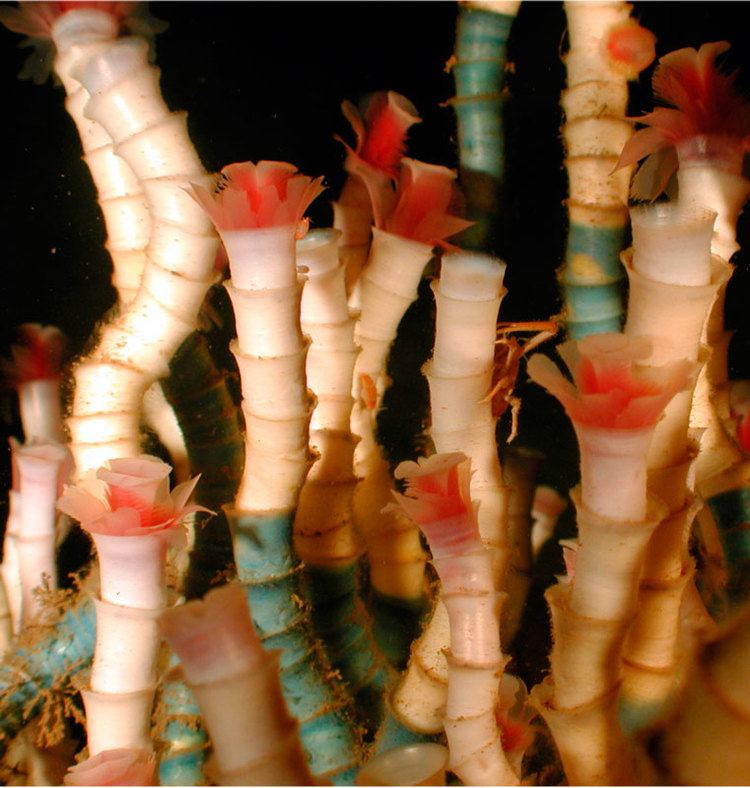 | ||
Lower classifications Giant tube worm, Lamellibrachia, Osedax | ||
Spawning and development in osedax boneworms siboglinidae annelida
Siboglinidae, also known as the beard worms, is a family of polychaete annelid worms whose members made up the former phyla Pogonophora (the giant tube worms) and Vestimentifera. They are composed of about 100 species of vermiform creatures and live in thin tubes buried in sediments at ocean depths from 100 to 10,000 m. They can also be found in association with hydrothermal vents, methane seeps, with sunken plant material or whale carcasses.
Contents
- Spawning and development in osedax boneworms siboglinidae annelida
- Anatomy
- Evolution
- Vestimentiferans
- Genera in the family Siboglinidae
- References
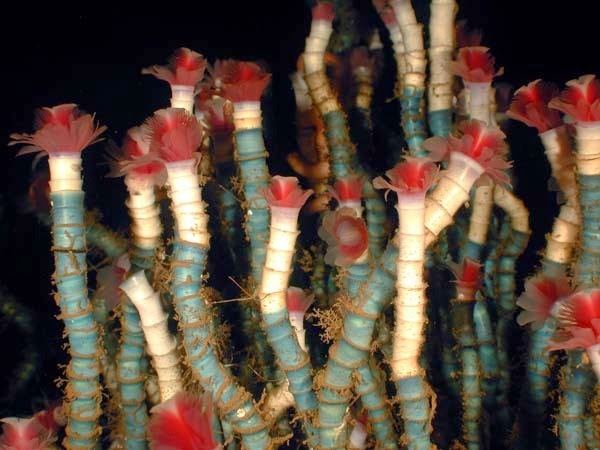
The first specimen was dredged from the waters of what is now Indonesia in 1900. These specimens were given to French zoologist Maurice Caullery, who studied them for nearly 50 years.
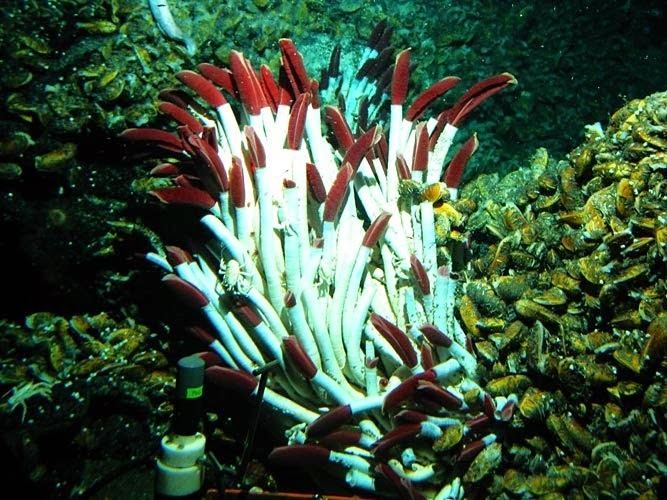
Spawning and development in osedax boneworms siboglinidae annelida
Anatomy
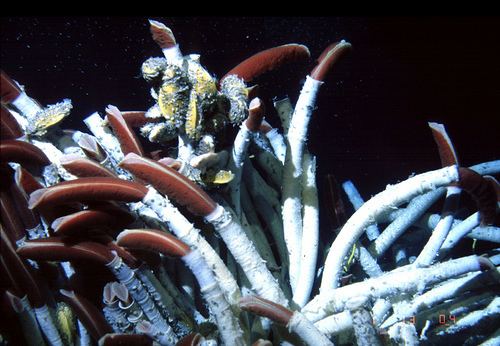
Most siboglinids are less than 1 millimetre (0.04 in) in diameter but 10–75 centimetres (3.9–29.5 in) in length. They inhabit tubular structures composed of chitin and fixed to the bottom. The tubes are often clustered together in large colonies.

The body is divided into four regions. The anterior end is called the cephalic lobe, which bears from 1 to over 200 thin branchial ciliated tentacles, each bearing tiny side branches known as pinnules. Behind this is a glandular forepart, which helps to secrete the tube. The main part of the body is the trunk, which is greatly elongated and bears various annuli, papillae, and ciliary tracts. Posterior to the trunk is the short metamerically segmented opisthosoma, bearing external paired chaetae, which apparently help to anchor the animal to the base of its tube.

The body cavity has a separate compartment in each of the first three regions of the body, and extends into the tentacles. The opisthoma has a coelomic chamber in each of its 5 to 23 segments, separated by septa. The worms have a complex closed circulatory system and a well-developed nervous system, but as adults, siboglinids completely lack a mouth, gut and anus.
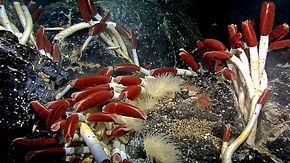
Siboglinids are dioecious, with one gonad on each side of the trunk, within the body cavity. The fertilised eggs develop within the tubes, and hatch to produce small ciliated worm-like larvae.
Evolution
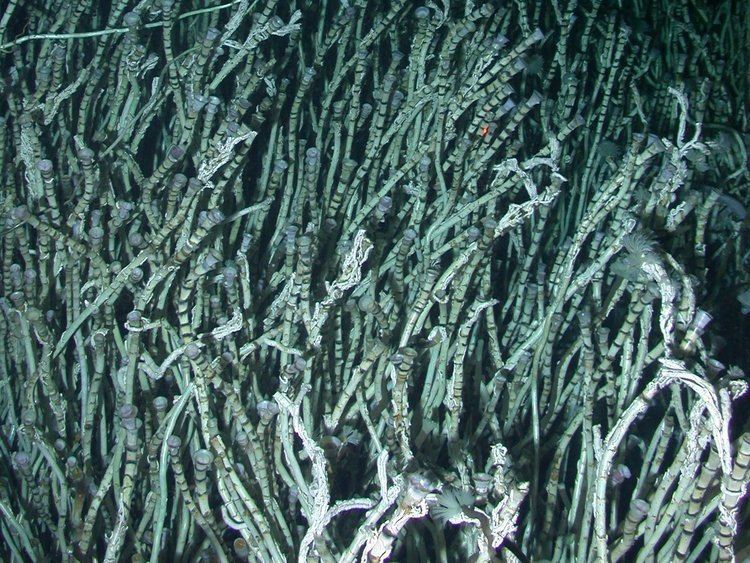
The family Siboglinidae has been difficult to place in an evolutionary context. By examining genetic differences between annelids there is now a scientific consensus that Siboglinidae is a family within the order Polychaeta. The fossil record along with molecular clocks suggests the family has Mesozoic (250 mya - 66 mya) or Cenozoic (66 mya - recent) origins. Examination of molecular work aligning five genes has made clear that there are four distinct clades within Siboglinidae. The clades are vestimentiferans, Sclerolinum, frenulates, and Osedax. These clades represent the four tracks evolution has followed within Siboglinidae. Vestimentiferans live in vent and seep habitats. Sclerolinum is a monogeneric clade living on organic-rich remains. Frenulates live in organic-rich sediment habitats. Osedax is a monogeneric clade specialized in living on whale bones, although recently there has been evidence of them living on fish bones as well.
Vestimentiferans
Like other tube worms, vestimentiferans are marine and benthic. Riftia pachyptila, a vestimentiferan, is known only from the hydrothermal vent systems. The vestimentiferans possess an anterior first body part called the obturaculum. Their main trunk of the body bears winglike extensions, the vestimentum, from which their name is derived. Also, unlike other siboglinids that never have a digestive tract, they have one that they completely lose during metamorphosis. Their primary nutrition is derived from the sulphide-rich fluids emanating from the hydrothermal vents they live by. The sulphides are metabolized by symbiotic hydrogen sulfide- or methane-oxidizing bacteria living in an internal organ, the trophosome. One gram of trophosome tissue can contain one billion bacteria. It is not completely understood how the worms instigate their relationship with the bacteria. One theory is that the very young worm has a vent on its body permitting the entry of the bacteria from the water. A more recent study of three species of tubeworms including Riftia pachyptila demonstrated that the bacteria actually infect juvenile worms through their skin. Their body is divided into four regions; the obturaculum, vestimentum, trunk, and opisthosome.
Discovery of the hydrothermal vents in the eastern Pacific Ocean was quickly followed by the discovery and description of new vestimentiferan tubeworm species. These tubeworms are one of the most dominant organisms associated with the hydrothermal vents in the Pacific Ocean. Tubeworms anchor themselves to the substratum of the hydrocarbon seep by roots located at the basal portion of their bodies. Intact tubeworm roots have proven very difficult to obtain for study because they are extremely delicate, and often break off when a tubeworm is removed from hypothermal vent regions. It is unsure how long the roots of the tube worms can grow to, but root have been recovered longer than 30 m in length. A single aggregation of tubeworms can contain thousands of individuals, and the roots produced by each tubeworm can become tangled with the roots of neighbouring tubeworms. These mats of roots are known as “ropes”, and travel down the tubes of dead tubeworms, and run through holes in rocks. The diameter and wall thickness of the tubeworm roots do not appear to change with distance from the trunk portion of the tubeworms body. Like the trunk portion of the body, the roots of the Vestimentiferan tubeworms are composed of chitin crystallites, which support and protect the tubeworm from predation and environmental stresses. The Vestimentiferan tubeworms build the external chitin structure themselves by secreting chitin from specialized glands located in their body walls.
